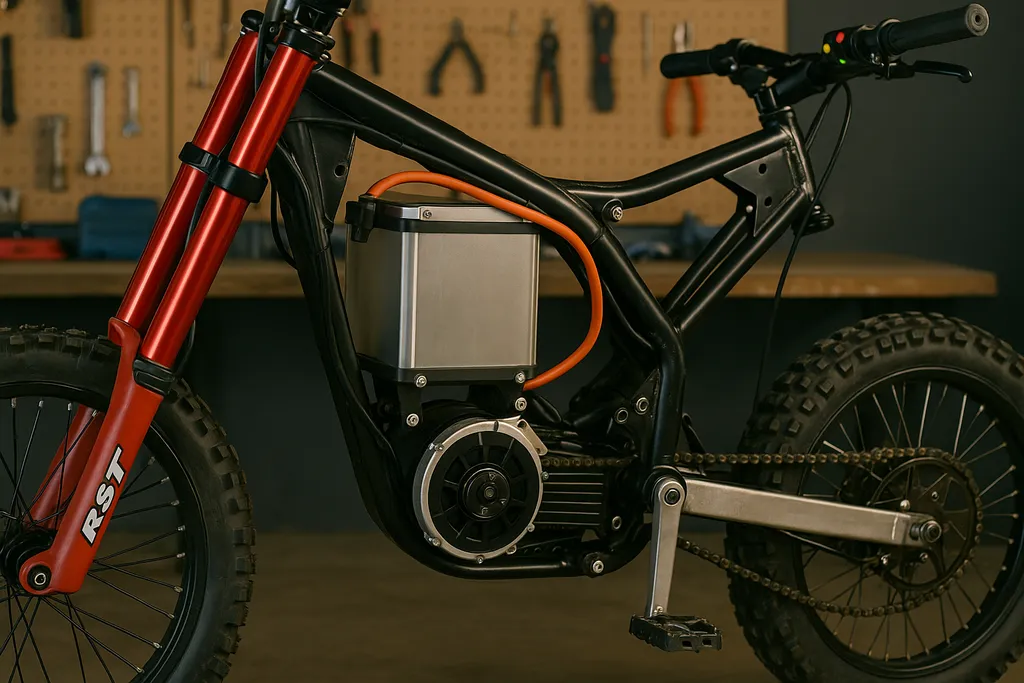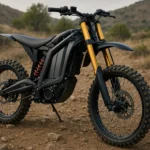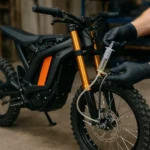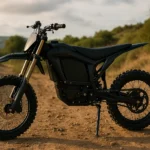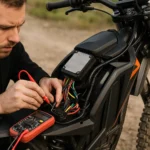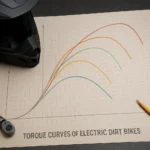If you’ve ever wondered how to build an electric dirt bike, you’re not alone — it’s one of the most exciting DIY projects for riders and tinkerers alike.
Whether you’re dreaming of carving up trails or building a custom machine that fits your vibe perfectly, this guide will walk you through the full process from frame to throttle ⚡
How to Build an Electric Dirt Bike isn’t just a technical task — it’s an adventure.
It’s about picking the right electric motor, understanding battery voltage, choosing a solid dirt bike frame, and putting it all together in a way that screams performance and style.
Along the way, we’ll explain motor wattage, amp-hours, BMS systems, and all those intimidating terms in a fun, easy-to-grasp way.
So, if you’ve got some tools, a bit of patience, and a passion for speed — you’re in the right place.
We’ll explore every component you need to bring your custom electric dirt bike to life:
From high-torque mid-drive motors to lightweight aluminum frames, from brushless controllers to rugged off-road tires, you’ll learn exactly how each part fits into the puzzle.
And yes — we’ll even cover how to make your build street legal, if that’s your goal. 💡
This is the How to Build an Electric Dirt Bike resource that goes beyond the fluff. You’ll find real advice, community-tested tips, and all the tricks you won’t get from basic YouTube tutorials.
Wanna build a beast that leaves the store-bought bikes in the dust? Let’s roll.
Key Takeaways
- Learn the exact parts you need to build a custom e-dirt bike
- Discover how motor, battery, and frame work together
- Step-by-step instructions with real examples and expert tips
- Avoid common mistakes that can ruin your DIY build
- Build a street-legal or off-road beast depending on your goal
⚡ Wanna skip ahead? Use the quick links below to find the section you’re most interested in 👇
What is an Electric Dirt Bike and Why Build One Yourself?
Before diving into how to build an electric dirt bike, let’s break down what it actually is — and why building one from scratch might be the smartest move you’ll ever make.
An electric dirt bike is a high-torque, battery-powered two-wheeler designed for off-road fun. Instead of a gas engine, it runs on a powerful electric motor and a rechargeable battery pack.
Sounds simple, right? But when you build your own, you control everything — from performance specs to the look and feel of the ride.
So, why learn how to build an electric dirt bike instead of just buying one?
Because it’s not just cheaper — it’s better.
By customizing your own build, you get to:
- Choose the motor power and battery range that fits your ride style
- Reinforce the frame for jumps or rugged terrain
- Optimize for speed, torque, or battery life
- Add your own mods like regenerative braking, smart displays, or even solar charging systems
Building an e-dirt bike yourself also gives you an intimate understanding of how it works. That means easier repairs, smarter upgrades, and confidence to tweak or push limits.
In short: How to build an electric dirt bike isn’t just a Google search — it’s a full-on journey.
You’ll learn DIY mechanics, basic electrical wiring, and how to make your build road-ready if needed.
And if you’re still wondering about the differences between factory-made and homemade e-dirt bikes, check out our beginner-friendly article:
👉 What is an Electric Dirt Bike?
Let’s keep going — it’s time to gear up. 🛠️
Essential Tools and Skills You’ll Need Before Starting
Alright, before we actually jump into how to build an electric dirt bike, you’ll need to make sure your garage (or your backyard workshop 😎) is ready for action.
This isn’t rocket science — but you’ll need a few tools, some basic skills, and a little patience.
Tools You Absolutely Need
- A quality set of Allen wrenches and socket wrenches
- Multimeter (to check voltage and troubleshoot wiring)
- Screwdrivers, zip ties, wire cutters, and soldering iron
- A drill and metal bits (for mounting components)
- Safety gear: gloves, goggles, and a fire extinguisher just in case
You can find most of these tools at your local hardware store or online kits made for e-bike builds. Nothing too fancy, promise.
Must-Have DIY Skills (Don’t Worry, You’ve Got This)
- Basic electrical knowledge – Understanding how to connect batteries, controllers, and motors
- Mechanical sense – How to mount and tighten components securely
- Patience and problem-solving – You’ll hit a few roadblocks (everyone does)
Here’s the thing: How to build an electric dirt bike isn’t about being an engineer. It’s about being curious and willing to learn.
There are plenty of communities online (like Reddit’s r/ebikes and Instructables) where you’ll find tutorials, diagrams, and advice when you’re stuck.
And don’t forget: everything you learn during this build — from torque specs to watt-hour calculations — will stay with you forever.
You’re not just making a bike… you’re becoming a builder. 💪
Ready to pick your frame? Let’s go.
Step 1: Choosing the Right Frame
This is where your journey on how to build an electric dirt bike officially begins — with the frame, the skeleton of your beast.
Get this wrong, and everything else becomes a headache. Get it right, and the rest of your build will fall into place like magic 🧩
Types of Frames You Can Use
- Dirt Bike Frames (Gas Conversion)
- Strong and ready for off-road abuse
- Great if you’re converting an old gas dirt bike
- Often heavier, but extremely durable
- Mountain Bike Frames (MTB)
- Lighter and more agile
- Good for lower-power motors (under 1500W)
- Needs reinforcement for jumps or rough terrain
- Custom or Kit Frames
- Designed specifically for electric builds
- Pre-drilled for battery, motor, and controller
- Can get pricey, but save tons of hassle
Frame Material: Steel vs Aluminum
- Steel = Tough, flexible, easier to weld, but heavy
- Aluminum = Light, rust-proof, harder to modify, but sleek
If this is your first time learning how to build an electric dirt bike, go with a steel frame. It’s more forgiving, especially if you need to weld or modify anything along the way.
Size and Suspension Matter
You’re not just building a showpiece — this thing needs to ride well.
Make sure your frame fits:
- Your height
- Wheel size (usually 19″–21″)
- Rear suspension type (swingarm or mono-shock)
- Mounting room for motor and battery
Where to Find a Good Frame
- Facebook Marketplace or Craigslist
- Salvage yards or dirt bike forums
- Local bike shops (ask for cracked or unused frames)
- E-bike builder websites with pre-fab kits
This step sets the tone for your entire build. How to build an electric dirt bike starts with picking a solid base — so don’t rush it. Take your time, measure twice, and dream big.
Up next? Let’s talk motors. 🔩
Step 2: Selecting the Electric Motor
Now that you’ve got your frame, it’s time to choose the muscle of your build — the motor.
This is one of the most important parts of how to build an electric dirt bike, and it determines your speed, torque, and climbing power 🏔️
Brushed vs Brushless Motors
- Brushed Motors
- Cheaper, easier to install
- More maintenance, less efficient
- Suitable for light-use or budget builds
- Brushless Motors (BLDC)
- More powerful and efficient
- Longer lifespan
- Better for serious off-road performance
- Highly recommended for any proper build
When you’re learning how to build an electric dirt bike, always go brushless if your budget allows. You’ll thank yourself later.
Hub Motor vs Mid-Drive
- Hub Motor (Rear Wheel)
- Easier to install
- Fewer moving parts
- Better for urban or trail riding
- Limits suspension and torque
- Mid-Drive Motor (Central Mount)
- Uses the bike’s gearing system
- More torque and better hill climbing
- Ideal for rugged terrain
- Requires custom mounting and stronger chain/sprockets
If you’re going all-in on your how to build an electric dirt bike project, mid-drive is the way to go. It’s more complex, but the performance upgrade is real.
Motor Power: How Many Watts Do You Need?
Let’s break it down by use case:
| Use Case | Recommended Power | Max Speed (Approx.) |
|---|---|---|
| Kids / Light Trail | 500W–1000W | 20–25 mph |
| Urban / Moderate | 1500W–3000W | 30–45 mph |
| Hardcore Off-Road | 3000W–5000W+ | 50+ mph |
Always match the motor with your controller and battery voltage — we’ll cover that in a bit.
Recommended Brands (Community Favorites)
- QS Motor – High-performance, widely used
- Sur-Ron Mid Drives – Great for hybrid builds
- Golden Motor – Popular for DIY conversions
- Cyclone Motors – Raw power and modular setups
Remember, in the world of how to build an electric dirt bike, the motor defines your ride.
Don’t cheap out unless you’re building for casual cruising. For hills, jumps, and speed? Go big or go home 💨
Next up, let’s talk batteries — the fuel that powers your electric stallion. 🔋
Step 3: Battery Basics – The Heart of Your Ride
Let’s be real — no matter how powerful your motor is, without the right battery, your electric dirt bike is just a glorified paperweight.
This is where how to build an electric dirt bike gets serious, because battery choice affects range, speed, and overall performance 🔋
Lithium-Ion vs LiFePO4: What’s Best?
- Lithium-Ion (Li-ion)
- High energy density (more power in less space)
- Common in e-bike builds
- Slightly less stable under extreme heat or abuse
- Lithium Iron Phosphate (LiFePO4)
- Safer and longer lifespan
- Heavier and bulkier
- Excellent for high-discharge builds (over 3000W)
If you’re planning a high-performance build and want extra safety, LiFePO4 is a solid choice. But for most DIY builds, Li-ion gives you the perfect balance between range and weight.
Voltage, Amp-Hours, and Watt-Hours Explained
Understanding this is key in how to build an electric dirt bike:
- Voltage (V) – Affects speed and motor compatibility
- Amp-Hours (Ah) – Determines how long the battery lasts
- Watt-Hours (Wh) – Total energy (V × Ah) = how far you can ride
💡 Example:
A 60V, 20Ah battery = 1200Wh = around 30–50 miles of range depending on terrain and throttle usage.
Should You Build Your Own Battery Pack?
- Pre-Built Packs
- Plug-and-play convenience
- Built-in BMS and casing
- Slightly more expensive
- DIY Packs
- Fully customizable
- Cheaper if you know what you’re doing
- Risk of bad welds, imbalance, or fire if done wrong
Unless you have experience with battery welding and BMS programming, stick to pre-built packs. The goal of how to build an electric dirt bike is fun, not frustration (or fire 😅).
Don’t Skip the BMS
A Battery Management System (BMS) is what keeps your pack safe from:
- Overcharging
- Deep discharging
- Overheating
- Cell imbalance
Skipping the BMS is the fastest way to turn your custom bike into a smoke bomb. No joke.
Top Battery Brands for DIY Builds
- Samsung 21700 cells – Long-lasting and reliable
- LG Chem – Common in high-discharge packs
- Unit Pack Power – Ready-to-ride battery kits
- EM3ev – Trusted by DIY communities
Choosing the right battery is one of the most crucial steps in how to build an electric dirt bike. Think of it as your fuel tank — the bigger and smarter it is, the further (and faster) you go.
Now let’s wire this beast up! On to controllers and throttle setups 🚦
Step 4: Controller, Throttle, and Wiring Setup
Now that you’ve got your motor and battery, it’s time to make them talk to each other — and that’s where the controller comes in.
In the how to build an electric dirt bike process, the controller acts like the brain of your machine 🧠 It tells the motor how much power to deliver based on your throttle input.
Matching Controller to Motor and Battery
To avoid a frustrating build (and fried components), your controller specs must align with:
- Motor voltage and wattage
- Battery output (V and Amps)
- Type of motor (brushless, mid-drive, etc.)
For example, a 72V 3000W motor needs a controller that can handle 72V and deliver at least 50A of continuous current.
Popular Controller Types
- Sine Wave Controllers
- Smooth acceleration
- Quieter operation
- Ideal for street and trail builds
- Square Wave Controllers
- Cheaper and punchier
- Slightly noisier
- Better for budget or aggressive off-road setups
Choosing Your Throttle
There are two main styles:
- Twist Throttle – Like a motorcycle. Natural for riders.
- Thumb Throttle – Easier on the wrist during long rides. Great for technical trails.
Pick the one that feels right. It’s all personal preference here.
Wiring: Keep It Clean and Safe
One of the trickiest parts of how to build an electric dirt bike is the wiring.
A messy wiring job can lead to shorts, weak throttle response, or worse — a dead bike mid-ride. 😬
Tips for a Pro-Level Wiring Setup:
- Use color-coded wires or label them
- Add heat-shrink tubing to exposed connections
- Route wires along the frame using zip ties
- Avoid placing wires near suspension or moving parts
- Use fuse protection between battery and controller
Sample Controller + Motor Pairings
| Motor Power | Voltage | Recommended Controller |
|---|---|---|
| 1000W | 48V | KT 48V 22A Controller |
| 3000W | 60V | Kelly KLS7230S |
| 5000W+ | 72V | ASI BAC8000 |
Note: Always double-check connector types (XT90, Anderson, bullet) before ordering. Mix-ups can slow down your build by weeks.
In short, this stage of how to build an electric dirt bike is about connectivity and control.
If your wiring is tight and your controller is matched properly, your bike will respond like a dream.
Up next — let’s make sure you can stop as fast as you go. Time for brakes, wheels, and suspension 🛞
Step 5: Brakes, Suspension, and Wheels
You’ve got power. You’ve got speed. But what good is all that if you can’t stop or handle bumps like a boss?
In how to build an electric dirt bike, this section is about control, comfort, and safety — three things you absolutely need before your first ride.
Brakes: Don’t Cut Corners Here
Forget stock brakes from old mountain bikes. A powerful e-dirt bike needs real stopping power, especially if you’re pushing 40+ mph.
Recommended Brake Types:
- Hydraulic Disc Brakes
- Best performance
- Smooth modulation and strong stopping force
- Popular brands: Tektro, Magura, Shimano Zee
- Mechanical Disc Brakes
- Cheaper, easier to maintain
- Less stopping power
- OK for builds under 1500W
💡 Tip: Go with 203mm rotors if you’re building a high-power rig.
Suspension: Keep Your Spine Happy
Your electric dirt bike will hit rocks, drops, and rough trails.
A good suspension setup keeps you in control — and keeps your teeth from rattling out.
Two Key Areas:
- Front Fork (Suspension Fork)
- Look for adjustable preload and rebound
- Brands like DNM USD-8 and RST Killah are DIY favorites
- Rear Suspension (Shock or Swingarm)
- Ensure your frame is compatible
- Choose based on rider weight and riding style
- Don’t forget bushings and bearings for smooth travel
Wheels and Tires: Grip Over Glam
Your wheelset supports everything — motor torque, rider weight, terrain abuse. It’s a major part of how to build an electric dirt bike that actually works off-road.
Best Practices:
- Wheel Size
- 19″ or 21″ for off-road stability
- Smaller wheels = more torque, less top speed
- Rim Strength
- Double-wall aluminum for better impact resistance
- Tires
- Knobby tires for dirt, sand, and gravel
- Hybrid tires for street/trail combo builds
- Brands like Kenda and Maxxis dominate the game
Pro Setup Combo (Example)
| Component | Recommendation |
|---|---|
| Front Fork | DNM USD-8 |
| Rear Shock | Fastace Coil Shock |
| Brake System | Magura MT5e Hydraulic |
| Wheel Size | 19″ Front / 18″ Rear |
| Tires | Maxxis MaxxCross IT |
Having a strong brake and suspension setup can mean the difference between enjoying your ride and ending it in a bush. 😅
Take your time with this step. How to build an electric dirt bike isn’t just about going fast — it’s about riding smart.
Let’s move on to the fun part: putting it all together and giving it a test run! 🔧
Step 6: Final Assembly and Testing
You’ve gathered all the parts, wired everything up, and now it’s time for the grand finale.
This step in how to build an electric dirt bike brings everything together — and makes your project officially road (or trail) ready! 🏁
Mounting Your Components Securely
This is not the time for duct tape and zip-tie engineering (well, maybe a few zip ties 😅). Your frame should now hold:
- The battery – ideally inside a protective case or bag, bolted to the frame or rear rack
- The motor – mounted using brackets or welded plates, depending on type
- The controller – positioned with airflow in mind (to prevent overheating)
- All wires and cables – routed cleanly and safely away from suspension, brakes, or tire rub
💡 Tip: Use foam padding or rubber spacers around battery packs to reduce vibrations and avoid damage during jumps.
Testing Before First Ride
Here’s your pre-ride checklist — follow it like gospel:
✅ Throttle response is smooth and progressive
✅ Brakes are firm and centered
✅ All connections are tight (especially battery leads)
✅ No exposed wires or sparks on power-up
✅ Motor runs quiet and cool
✅ Tires are inflated to the correct PSI
✅ Suspension is dialed for your weight
First Ride: What to Expect
Your first test run should be in a safe, open area. Avoid traffic or rough terrain right away. Use this time to:
- Listen for odd noises or vibration
- Check heat levels on the motor and controller
- Feel how the throttle ramps power
- Note handling and braking response
Take it slow — this is your chance to tune the bike to your style. Even the best DIY electric dirt bike needs a little tweaking.
Common First-Ride Fixes
- Loose bolts on the battery mount
- Sloppy cable routing interfering with brakes or throttle
- Throttle curve too sensitive (can be adjusted in controller settings)
- Chain tension or wheel alignment off-center
Remember, how to build an electric dirt bike doesn’t end the moment you ride. It evolves — and so will your build. The more you ride it, the better you’ll know how to improve it.
Ready for the next level? Let’s explore upgrades and advanced mods that take your ride from great to insane. 🔥
Advanced Mods and Add-Ons (Optional But Game-Changing)
Alright, you’ve built your machine and taken it for a spin — but why stop there?
One of the coolest parts of how to build an electric dirt bike is the ability to upgrade and customize it however you want.
These advanced mods aren’t required, but they’ll seriously boost your ride’s performance, safety, and style 🔧✨
Regenerative Braking
- Converts braking energy back into battery charge
- Extends range slightly and reduces brake wear
- Available in many modern controllers (just needs to be enabled)
Great for downhill rides or urban stop-and-go traffic. It’s subtle, but effective.
Smart Display & App-Based Tuning
- Swap out your basic voltmeter for a full-color LCD with real-time speed, range, power draw, and temperature
- Some setups (like ASI BAC controllers) allow Bluetooth tuning via app
- You can adjust throttle curves, power limits, and regen braking on the fly
It’s like giving your bike a brain — and full control is addictive.
Street-Legal Add-Ons
If you want to ride your build on public roads, you’ll probably need:
- Headlights, taillights, and turn signals
- Rearview mirrors
- Horn or bell
- License plate mount (if required in your state)
Make sure your controller supports 12V accessories or install a DC step-down converter from the main battery.
GPS Tracker & Anti-Theft System
- Hide a small GPS unit inside your battery case or under the seat
- Track your bike in real-time via phone app
- Add an alarm module with motion detection for extra protection
You worked hard on this bike — don’t let anyone steal your masterpiece.
Solar Charging System
Yep, it’s possible.
Install a solar panel + MPPT charge controller for off-grid recharging — perfect for camping trips or eco-conscious riders.
While it won’t replace a wall charger for daily use, it’s a sweet backup option.
Upgrade Ideas from the DIY Community
| Mod Type | What It Adds | Estimated Cost |
|---|---|---|
| Hydraulic Brakes | Better stopping power | $120–$250 |
| Suspension Fork | Smoother ride, better control | $150–$400 |
| Custom Seat | Comfort on long rides | $40–$100 |
| Fat Tires | Better grip and float | $80–$160 |
| Frame Reinforce | Handles jumps and crashes better | $50–$100 |
This is where how to build an electric dirt bike becomes more than a DIY — it becomes yours. Unique. Tuned. Unstoppable.
Coming up: Let’s make sure you ride smart, safe, and legal with some final tips 🛡️
Legal Considerations and Safety Tips
You’ve built your custom ride — now let’s make sure you can actually enjoy it without fines, accidents, or unwanted surprises.
In how to build an electric dirt bike, understanding the legal and safety side is just as important as torque and speed 🛡️
Is Your Build Street Legal?
Every region has its own rules, but here are some common requirements for a street-legal electric dirt bike in the U.S.:
- Motor power typically limited to 750W for unregistered street use
- Top speed capped at 20–28 mph depending on classification
- Must include:
- Headlight
- Taillight and brake light
- Turn signals
- Horn
- Rearview mirror
- DOT-approved tires
If your e-dirt bike exceeds those specs, it might be classified as a motorcycle or moped, which requires:
- License and registration
- Insurance in many states
- Helmet use (mandatory almost everywhere)
Always check with your local DMV or state laws. Regulations vary and can change yearly.
👉 For a helpful overview, check the U.S. Department of Transportation Motorcycle Classification Guide
Off-Road? Still Not a Free-for-All
Even off-road parks can have rules:
- Some trails ban motorized vehicles entirely
- Others limit speed or motor power
- Many require helmets and protective gear
Never assume you’re in the clear — research your riding location ahead of time.
Safety Gear You Should Always Wear
- DOT-approved helmet
- Motorcycle gloves with wrist protection
- Armored jacket or jersey with pads
- Knee and shin guards
- Sturdy boots with ankle protection
You spent time and money learning how to build an electric dirt bike — now protect that investment (and your bones) 💥
Fire and Charging Safety
Lithium batteries are powerful — and risky if mistreated:
- Charge in a fire-safe area
- Never leave batteries charging unattended
- Use a smart charger with auto shutoff
- Avoid physical damage or exposure to water
Installing a battery fuse and reliable BMS will go a long way toward keeping things safe.
You’re almost done. Next up — check out how the community is building their own epic rides! 🔧🚀
Real DIY Builds from the Community
One of the best parts of diving into how to build an electric dirt bike is seeing what others have created.
From backyard builds to full-blown monsters, the DIY e-dirt bike community is packed with creativity, hacks, and inspiration 🔥
Build #1: The Backyard Budget Beast
- Builder: @TrailTechMike on Reddit
- Frame: Old Honda CRF50
- Motor: 3000W hub motor
- Battery: 60V 20Ah DIY pack
- Cost: Around $900
Mike reused an old dirt bike frame, welded custom brackets for the motor, and sourced most parts from eBay.
He claims it hits 45 mph and gets 30 miles per charge. Total build time: 3 weekends.
Build #2: The Stealth Urban Commando
- Builder: YouTube – “Electric Dave Builds”
- Frame: Aluminum MTB
- Motor: Bafang BBSHD mid-drive
- Battery: 52V 17.5Ah Dolphin Pack
- Cost: ~$1,500
This bike was made for commuting but with dirt in its DNA. With pedal assist and thumb throttle, Dave gets a quiet ride that handles curbs and trails.
His wiring is clean, and the build looks stock — perfect for city stealth missions 🕶️
Build #3: The Trail Conqueror Pro-Level Rig
- Builder: @WattWarrior on Instagram
- Frame: Custom steel with long-travel suspension
- Motor: QS 5000W mid-drive
- Battery: 72V 30Ah with smart BMS
- Cost: $3,200+
This beast is built to take punishment. WattWarrior added regenerative braking, GPS tracking, and a solar-powered auxiliary battery.
It rips through mountain trails and has torque to spare. Definitely not for beginners, but insanely cool to study.
What You Can Learn From These Builds
- You don’t need a fat wallet to get started
- Reusing parts and learning to solder goes a long way
- A clean wiring job = fewer problems
- Testing in stages helps avoid major breakdowns
- Community forums are full of free knowledge
Seeing real-world results is a huge motivator. These builders started where you are — with an idea and some guts.
Now it’s your turn. And if you’re still unsure about how to build an electric dirt bike, remember: done is better than perfect. Start small, tweak as you go, and have fun doing it.
Let’s wrap this up and talk about what you can do next. 🏆
Spread the Word and Share Your Build
You made it! You now know exactly how to build an electric dirt bike from the ground up — and you’ve got the power, knowledge, and tools to make it real ⚡
So what’s next? Simple: share your progress, inspire others, and keep learning.
The DIY e-dirt bike scene thrives on community support — and your build could be the push someone else needs to start their own project.
Here’s how you can help grow the movement:
- 📸 Post a photo or video of your build on Instagram, Reddit, or YouTube
- 🛠️ Share your setup, cost breakdown, and ride footage
- 💬 Leave a comment below with your motor and battery combo
- 🔗 Link to this guide to help others learn how to build an electric dirt bike
And hey — if you found this guide helpful, send it to a friend who loves bikes, tech, or just tinkering in the garage.
Let’s keep this energy rolling and turn more weekend warriors into electric dirt bike builders.
Want to go back and understand the core of these machines?
👉 Check out our complete beginner’s guide on What is an Electric Dirt Bike
See you on the trails. Ride safe, ride smart — and ride electric! 🏁
Frequently Asked Questions (FAQs)
You’ve come a long way in this guide on how to build an electric dirt bike, but if you’re still scratching your head about a few things — you’re not alone.
Here are some of the most common questions from fellow DIY builders:
Can I convert a gas dirt bike into electric?
Absolutely. Many builders start by stripping down an old gas frame and replacing the engine with an electric motor and battery.
Just make sure there’s enough room for mounting the motor and battery securely.
How much does it cost to build an electric dirt bike?
It depends on how wild you go. Budget builds can cost as little as $800, while high-performance rigs can hit $3,000+.
Most DIY projects fall somewhere between $1,200 and $2,000.
How fast can a DIY electric dirt bike go?
With the right setup, easily 40–60 mph. But speed depends on motor wattage, battery voltage, and total weight.
Pro tip: Don’t chase speed if you’re new — focus on control and safety first.
Do I need a license or registration?
If you’re riding off-road on private land — no.
But for public roads or trails, check your local laws. In most states, bikes over 750W or 28 mph require registration and insurance.
What’s the ideal motor and battery combo for beginners?
A solid starting point is a 1500W–3000W brushless motor with a 52V 20Ah battery.
It offers great performance without being too overwhelming to install or handle.
Where can I buy the parts?
- Online marketplaces: AliExpress, Amazon, eBay
- E-bike retailers: Luna Cycle, Grin Technologies, EM3ev
- Local classifieds and bike shops for frames and used parts
Can I charge the bike with a solar panel?
Yes — with a solar charge controller and compatible panel, you can trickle-charge your battery.
Great for off-grid use or eco-friendly setups, though slower than wall charging.
Still have questions? Drop them in the comments or hit us up on social.
We’re all learning together here at Electric Dirt Zone 🙌

Tyler Brooks is the storyteller behind most of the content at Electric Dirt Zone. With over 10 years of experience in digital media and a lifelong love for off-road riding, he blends technical insight from the team with engaging, down-to-earth writing. When he’s not turning dusty trail rides into blog posts, you’ll probably find him snapping pics before things get too wild.

